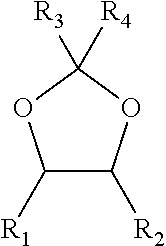Process for separating ethylene glycol and 1, 2-butanediol
a technology of ethylene glycol and ethylene glycol, which is applied in the field of separating the mixture containing ethylene glycol and 1, 2butanediol, can solve the problems of large investment, many theoretical plates, and large investment for rectification, and achieves small investment, high energy consumption, and high efficiency.
- Summary
- Abstract
- Description
- Claims
- Application Information
AI Technical Summary
Benefits of technology
Problems solved by technology
Method used
Image
Examples
example s
[0020]The present invention will be further elaborated through the following examples.
[0021]Example 1
[0022]The process flow as shown in FIG. 1 was used. Material flow 1 was the liquid phase product obtained by the hydrogenation of oxalate and had the following components by weight percentage: methanol 85.65%, ethanol 0.20%, methyl glycolate 0.15%, dimethyl oxalate 0.45%, 1,2-propylene glycol 0.21%, 1,2-butanediol 0.40%, ethylene glycol 12.20%, diethylene glycol and other light and heavy components 0.84%.
[0023]The first separating column C1 was the first light component-removal column and had 20 theoretical plates, material flow 1 was introduced from the 15th theoretical plate, the operating pressure was atmospheric pressure, the reflux ratio was 0.5, the temperature at the top of the column was 64.2° C., the temperature at the bottom of the column was 92.7° C., and the weight percentages of the components ethylene glycol and 1,2-butanediol in material flow 3 at the bottom of the col...
example 2
[0027]The process flow as shown in FIG. 1 was used. Material flow 1 was the solution containing ethylene glycol and 1,2-butanediol and had the following components by weight percentage: methanol 29.46%, dimethyl oxalate 3.15%, 1,2-propylene glycol 1.18%, 1,2-butanediol 0.33%, ethylene glycol 65.09%, and other light and heavy components 0.79%.
[0028]The first separating column C1 had 10 theoretical plates, material flow 1 was introduced from the 8th theoretical plate, the operating pressure was atmospheric pressure, the reflux ratio was 0.3, the temperature at the top of the column was 64.2° C., the temperature at the bottom of the column was 192.5° C., and the weight percentages of the components ethylene glycol and 1,2-butanediol in material flow 3 after 95% methanol was removed by the first light component-removal column Cl were: 92.33%, 0.47%.
[0029]The second separating column C2 had 30 theoretical plates, material flow 3 was introduced from the 20th theoretical plate, the operati...
example 3
[0031]The process flow as shown in FIG. 1 was used. Material flow 1 was the solution containing ethylene glycol and 1,2-butanediol and had the following components by weight percentage: methanol 67.75%, ethanol 0.10%, dimethyl oxalate 0.5%, 1,2-propylene glycol 0.16%, 1,2-butanediol 0.45%, ethylene glycol 30.10%, and other light and heavy components 0.94%.
[0032]The first separating column C1 had 15 theoretical plates, material flow 1 was introduced from the 10th theoretical plate, the operating pressure was atmospheric pressure, the reflux ratio was 0.5, the temperature at the top of the column was 64.2° C., the temperature at the bottom of the column was 95.8° C., and the weight percentages of the components ethylene glycol and 1,2-butanediol in material flow 3 after 93% methanol was removed by the first light component-removal column Cl were: 81.76%, 1.23%.
[0033]The second separating column C2 had 40 theoretical plates, material flow 3 was introduced from the 30th theoretical plat...
PUM
| Property | Measurement | Unit |
|---|---|---|
| operating pressure | aaaaa | aaaaa |
| operating pressure | aaaaa | aaaaa |
| operating pressure | aaaaa | aaaaa |
Abstract
Description
Claims
Application Information
 Login to View More
Login to View More - R&D
- Intellectual Property
- Life Sciences
- Materials
- Tech Scout
- Unparalleled Data Quality
- Higher Quality Content
- 60% Fewer Hallucinations
Browse by: Latest US Patents, China's latest patents, Technical Efficacy Thesaurus, Application Domain, Technology Topic, Popular Technical Reports.
© 2025 PatSnap. All rights reserved.Legal|Privacy policy|Modern Slavery Act Transparency Statement|Sitemap|About US| Contact US: help@patsnap.com



